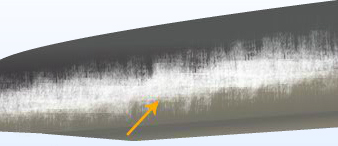
Ice or frost accumulations increase drag and rob an aircraft of critical lift. Accumulations no thicker or rougher than coarse sandpaper on the leading edge and upper surface of a wing can reduce lift by as much as 30 percent and increase drag by as much as 40 percent.
Why Ice is Bad
When you add power to compensate for the additional drag, and lift the aircraft’s nose to maintain altitude, the angle of attack increases, allowing the underside of the wings and fuselage to accumulate additional ice.
Ice accumulates on every exposed frontal surface of the airplane—not just on the wings, propeller, and windshield, but also on the antennas, vents, intakes, and cowlings. Ice builds in flight where no heat or deicing boots can reach it, and it can cause antennas to vibrate so severely that they break. In moderate to severe conditions, a light aircraft can become so iced up that continued flight is impossible. The airplane may stall at much higher speeds and lower angles of attack than normal—it can roll or pitch uncontrollably, and recovery might be impossible.
Pilot Safety Announcement: It’s a Drag
Watch how layers of clothing can drag you down. The same can happen with layers of icing!
Structural Icing
This type of icing forms on the outside of the aircraft with temperatures near freezing and some type of visible moisture present (for example, clouds, freezing mist, freezing rain, etc.).
Flying the Weather: Airframe Icing
Hear from weather expert and AOPA Pilot magazine writer, Tom Horne, on the dangers of flight into "known icing" conditions and what you can do to escape those conditions with your life.
Icing Types:
Clear Ice
 Composition:
Composition:
A glossy, transparent ice formed by the relatively slow freezing of supercooled liquid water.
Note:
Often found in cumulus clouds, clear ice can be caused by:
- Temperatures close to the freezing point (0 to -10 degrees C)
- Large amounts of liquid water
- Large drops
Rime Ice
 Composition:
Composition:
A rough, milky, opaque ice formed by the instantaneous or very rapid freezing of small supercooled water droplets as they strike the aircraft.
Note:
Often found in stratus clouds, rime ice can be caused by:
- Low temperatures—generally -10 to -20 degrees C—but with smaller drops, it can occur at warmer subfreezing temperatures
- Lesser amounts of liquid water
- Small droplets
Frost
 Composition:
Composition:
Forms on parked aircraft when water vapor turns directly to ice, skipping the liquid stage (deposition).
Note:
Even a light layer of frost can increase drag and rob an airplane of critical lift.
Tip: Mixed ice is a combination of clear and rime ice formed on the same surface. Its unique shape and roughness significantly decrease lift.
Ice accumulates on every exposed frontal surface of the airplane—not just on the wings, propeller, and windshield, but also on the antennas, vents, intakes, and cowlings.
Distortion
Structural ice distorts the air flowing over the wing. This diminishes the wing’s ability to produce lift and reduces the angle of attack for maximum lift. Ice also adversely affects airplane handling qualities and significantly increases drag.
Your airplane will have:
- Decreased climb performance
- Increased stall speed
- Increased landing speed
- Increased weight
- Potential for shifted center of gravity

If you fly somewhere for a quick dinner on a chilly night, you could find the airplane covered in frost before dessert arrives.
Ice is Not Nice
The Aeronautical Information Manual (AIM) defines various levels of structural icing: trace, light, moderate, and severe. As the severity level increases, the amount of time for pilots to escape the icing conditions drops dramatically.
Icing Levels:
Trace
 Accumulation Rate:
Accumulation Rate:
Ice becomes perceptible. Accumulation rate is slightly greater than sublimation rate.
Significance:
Evaluate escape options and exit as soon as possible.
Light
 Accumulation Rate:
Accumulation Rate:
Accumulation rate may create a problem if flight is prolonged in this environment.
Significance:
Very dangerous for light GA aircraft. Noticeable loss of performance is likely within just a few minutes.
Moderate
 Accumulation Rate:
Accumulation Rate:
Accumulation rate is such that even short encounters become potentially hazardous.
Significance:
Extremely hazardous for light GA aircraft. Immediate exit required.
Severe
 Accumulation Rate:
Accumulation Rate:
Accumulation rate is such that even aircraft with deicing/anti-icing equipment must divert immediately.
Significance:
Emergency situation for light GA aircraft; loss of control imminent.
Note: For a typical GA aircraft, even the lowest level of icing means trouble!
Induction Icing
This type of icing, also known as induction system ice, restricts the airflow to the engine. There are two kinds of induction system icing: carburetor icing (affects engines with carburetors) and air intake blockage (affects both carbureted and fuel injected engines).
Carbureted Engines—These are especially susceptible to induction icing because of the venturi effect within the carburetor. It is possible for carburetor ice to form (particularly when engine rpm is low) even when the skies are clear and the outside air temperature is as high as 90 degrees F, if the relative humidity is 50 percent or more. But carburetors can ice up at cruise power when flying in clear air and in clouds if relative humidity and temperatures range between 60 and 100 percent and 20 and 70 degrees F, respectively.
Fuel Injected Engines—These also need air to operate. When conditions are favorable for structural ice, fuel injected engines can lose power and even fail if the air filter and intake passages are blocked by ice. Many aircraft are equipped with an alternate air source in the event ice blocks the primary air intake.
Tip: Both carburetor heat and alternate air sources use unfiltered air. They should be closed when on the ground, unless conditions are conducive to engine icing while taxiing.
